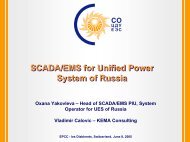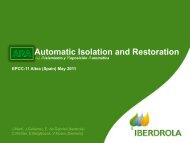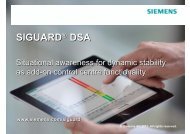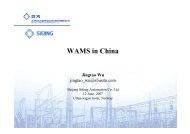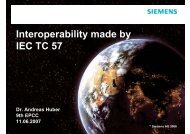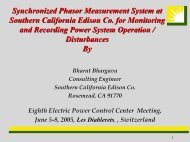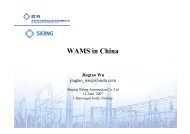SIGUARD PSA
SIGUARD PSA - Epcc-workshop.net
SIGUARD PSA - Epcc-workshop.net
- No tags were found...
You also want an ePaper? Increase the reach of your titles
YUMPU automatically turns print PDFs into web optimized ePapers that Google loves.
<strong>SIGUARD</strong> ® <strong>PSA</strong><br />
Protection security assessment<br />
for control centers and studies<br />
www.siemens.com/siguard<br />
© Siemens AG 2012. All rights reserved.
Prof. Dr.-Ing. Rainer Krebs<br />
Principal Expert Power Technologies<br />
Head of Protection and Control System Studies<br />
Siemens AG, Infrastructure & Cities Sector<br />
IC SG SE PTI NC PCS, Erlangen, Germany<br />
Honorary Professor for System Protection and Control<br />
Otto-von-Guericke University Magdeburg, Germany<br />
German Member in working groups of: IEC, CIGRE, IEEE, DKE, T&D Europe<br />
Board Member of VDE Bavaria<br />
Page 2<br />
2013-06 R. Krebs<br />
© Siemens AG 2012. All rights reserved.<br />
IC SG SE PTI
Content<br />
• Field Examples<br />
• Protection System Review: classical and new<br />
• The Solution: <strong>SIGUARD</strong> ®<br />
• The Protection Security Assessment<br />
<strong>SIGUARD</strong> ® <strong>PSA</strong><br />
• References<br />
Page 3<br />
2013-06 R. Krebs<br />
© Siemens AG 2012. All rights reserved.<br />
IC SG SE PTI
Content<br />
• Field Examples<br />
• Protection System Review: classical and new<br />
• The Solution: <strong>SIGUARD</strong> ®<br />
• The Protection Security Assessment<br />
<strong>SIGUARD</strong> ® <strong>PSA</strong><br />
• References<br />
Page 4<br />
2013-06 R. Krebs<br />
© Siemens AG 2012. All rights reserved.<br />
IC SG SE PTI
Field Examples<br />
Incidents, causes, implications, consequences<br />
Fall Case I: I: Städtisches Urban Network Netz<br />
• Cause: weakness in the protection scheme<br />
• Implication: damaged S/S, disconnection of a large network area<br />
• Consequence: replacement & repair costs, damage of public image<br />
Case II: Rural Network<br />
Fall II: Regionales Netz<br />
• Cause: false protection settings<br />
• Implication: disconnection of an important industrial customer<br />
• Consequence: loss of production, complaint, migration of industrial plant<br />
Result of Root Cause Analysis<br />
Ergebnis der Fehlerklärung:<br />
• The causes of both incidents could have been found and corrected<br />
prior to the incidents if protection security assessments would have<br />
been performed<br />
• The enhancement of the protection scheme and the improvement<br />
of relay settings respectively would have avoided/ limited the physical<br />
and monetary damage of both incidents<br />
Page 5<br />
2013-06 R. Krebs<br />
© Siemens AG 2012. All rights reserved.<br />
IC SG SE PTI
Field Examples<br />
Root Cause Analysis<br />
Why were the fault causes not detected prior to the incidents?<br />
• Networks are continuously changing and consequently the performance<br />
and adequacy of the protection system must be regularly checked<br />
to detect limitations and weak points<br />
• Hidden faults, e.g. of the back-up protection, are mainly found by simulation<br />
of the combined power & protection system or by real disturbances<br />
• Protection system reviews are complex and time-consuming<br />
• Automated solutions are normally unavailable and consequently protection<br />
system reviews are not performed in regular intervals<br />
When should protection security assessments be performed?<br />
• For the root cause analysis after disturbances<br />
• In case of structural changes in network, e.g. construction projects<br />
• In case of changing operating conditions, e.g. new generation connections<br />
• For the determination and validation of new protection settings<br />
• For the verification of the correct protection function prior to switching<br />
actions<br />
• For the validation of remedial action in critical system conditions<br />
• After takeover of operation license for new network area<br />
Page 6<br />
2013-06 R. Krebs<br />
© Siemens AG 2012. All rights reserved.<br />
IC SG SE PTI
Field Examples<br />
Involvement of Protection Relays in Blackouts<br />
In 80% of all blackouts relays are involved<br />
• Zone 3 trips of distance relays,<br />
often used for overload protection instead of<br />
thermal models in numerical relays<br />
• Missing load and power swing blocking<br />
• Uncoordinated protection / or overload<br />
settings across borders or between diff.<br />
utilities<br />
• Too low synchro-check settings<br />
• OC backup in parallel to distance or<br />
differential protection without delay<br />
• Development of primary system without<br />
adaption of relaying design and relay settings<br />
Source: udoleuschner.de: 400kV Mettlen-Lavorgo Line<br />
Area of tree flashover starting the 2003 Italy Blackout<br />
Page 7<br />
2013-06 R. Krebs<br />
© Siemens AG 2012. All rights reserved.<br />
IC SG SE PTI
Content<br />
• Field Examples<br />
• Protection System Review: classical and new<br />
• The Solution: <strong>SIGUARD</strong> ®<br />
• The Protection Security Assessment<br />
<strong>SIGUARD</strong> ® <strong>PSA</strong><br />
• References<br />
Page 8<br />
2013-06 R. Krebs<br />
© Siemens AG 2012. All rights reserved.<br />
IC SG SE PTI
SH EBA<br />
1000,0 MVA<br />
0,1 p.u.<br />
ZW T G1 ZW T G2 ZWT G3 ZWT G4<br />
65,0 MVA 65,0 MV A 65,0 MVA 65,0 MVA<br />
0,1 p.u. 0,1 p.u . 0,1 p.u. 0,1 p.u.<br />
0,2 p.u. 0,2 p.u . 0,2 p.u. 0,2 p.u.<br />
G G G G<br />
ZW T G1 ZW T G2 ZW T G3 ZWT G4<br />
ZWT UT1<br />
68,0 MVA<br />
12,5 %<br />
ZWT UT2<br />
68,0 MVA<br />
12,5 %<br />
ZWT UT3<br />
68,0 MVA<br />
12,5 %<br />
ZWT UT4<br />
68,0 MVA<br />
12,5 %<br />
ZW T 220A ZW T 220B ZW T 2 20C ZWT 220D<br />
AL ALLOY bundle<br />
8,7 km<br />
AL ALLOY bundle<br />
8,7 km<br />
AL ALLOY bundle<br />
8,7 km<br />
GDB 220A<br />
GDB 220B<br />
ST _GD B-A ST _GDB -B ST_GDB-A ST _GD B B<br />
63,0 MVA 63,0 MVA 63,0 MVA 63,0 MVA<br />
12,6 %<br />
12,6 %<br />
9,9 %<br />
9,9 %<br />
GDB 30A GDB 30B GDB 66A GDB 66B<br />
L GDB A L GDB B L GDB A L GDB B<br />
10,1 MW 10,1 MW 10,1 MW 10,1 MW<br />
0,0 MVA r 0,0 MVA r 0,0 MVAr 0,0 MVAr<br />
JA L 220A<br />
JA L 220B<br />
JA L 30A<br />
L JAL A<br />
15,1 MW<br />
0,0 MVAr<br />
ST_JAL-A<br />
63,0 MVA<br />
9,9 %<br />
SRW 220A<br />
SRW 220B<br />
JA L 30B<br />
S RW 66A<br />
L JA L B<br />
15,1 MW<br />
0,0 MVA r<br />
L S RW A<br />
6,7 MW<br />
0,0 MVA r<br />
AL ALLOY bundle<br />
8,7 km<br />
BR 1-SR W<br />
25,0 MVA<br />
BR1-GDB<br />
50,0 MVA<br />
88 90<br />
73 75<br />
72 70<br />
AL ALLOY bundl e<br />
259,0 km<br />
ST _JAL-B<br />
63,0 MVA<br />
9,9 %<br />
74<br />
77<br />
AL ALLOY bundl e<br />
159,4 km<br />
78<br />
Le it un g 17<br />
AL ALLOY bundl e<br />
259,0 km<br />
76<br />
79<br />
L eit un g 18<br />
AL ALLOY bundl e<br />
159,4 km<br />
80<br />
ST _SR W-A ST _S RW -B<br />
63,0 MVA 63,0 MVA<br />
10,8 %<br />
10,8 %<br />
KUF TZR<br />
13 3, 0 MVA<br />
0, 1 p. u.<br />
SR W 66B<br />
L S RW B<br />
6,7 MW<br />
0,0 MVA r<br />
Leitung 16<br />
GMS 220A<br />
GMS 220B<br />
RE DW ING bundle<br />
86 ,4 km<br />
RE DW ING bundle<br />
86 ,4 km<br />
69<br />
71<br />
ST _GMS-A<br />
63,0 MVA<br />
10,8 %<br />
L GMS A<br />
3,9 MW<br />
0,0 MVA r<br />
GMS 66A<br />
L GMS B<br />
3,9 MW<br />
0,0 MVA r<br />
L eit un g 20<br />
68<br />
ST_GMS-B<br />
63,0 MVA<br />
10,8 %<br />
GMS 66B<br />
66<br />
GOOS E singl e<br />
144,3 km<br />
GOOS E singl e<br />
133,8 km<br />
REDWING bundle<br />
36,4 km<br />
Leitung 15 REDWING bundle<br />
36,4 km<br />
GWR 220 A<br />
GWR 220 B<br />
67<br />
65<br />
Leitung 21<br />
REDWING bundle<br />
8,8 km<br />
REDWING bundle<br />
8,8 km<br />
63 61<br />
20<br />
58<br />
18 60<br />
ST_GWR-B ST_GWR-A ST _GW R-B<br />
63,0 MVA<br />
12,6 %<br />
ST _GW R-A<br />
63,0 MVA<br />
63,0 MVA 63,0 MVA<br />
12,6 %<br />
9,9 % 9,9 %<br />
GWR 30A GW R 30B GWR 66A GWR 66B<br />
L GWR A L GWR B L GW R A L GWR B<br />
30,0 MW 30,0 MW 30,0 MW 30,0 MW<br />
0,0 MVA r 0,0 MV Ar 0,0 MVAr 0,0 MVA r<br />
BNS 220A<br />
BNS 220B<br />
64<br />
89<br />
86<br />
ST _BN S-4W<br />
62 60,0 MVA<br />
60,0 MVA<br />
60,0 MVA<br />
12,2 %<br />
27,8 %<br />
ST_BNS-B1<br />
12,7 %<br />
63,0 MVA<br />
9,9 %<br />
Leitung 14<br />
REDWING bundle<br />
25,4 km<br />
REDWING bundle<br />
25,4 km<br />
BNP 220A<br />
BNP 220B<br />
55 53<br />
BNP 30A BNP 30B<br />
L eit un g 22<br />
L BNP A L BNP B<br />
35,3 MW 35,3 MW<br />
0,0 MVA r 0,0 MVAr<br />
XLPE CABLE<br />
15,0 km<br />
BN C 30B<br />
B NC 30A<br />
L B NC B L BNC A<br />
16 ,5 MW 16,5 MW<br />
0,0 MVAr 0,0 MVAr<br />
XLPE CABLE<br />
15,0 km<br />
56 54<br />
BNC 220A<br />
BNC 220B<br />
ST_BNC-B ST_BNC-A<br />
63,0 MVA 63,0 MV A<br />
9,9 %<br />
9,9 %<br />
GO OS E s i ngl e<br />
10,5 km<br />
Leitung 19<br />
ST _BN P- A<br />
63,0 MVA<br />
9,9 %<br />
85 87 50 52 48<br />
BUT 220A<br />
BUT 220B<br />
57 59<br />
ST_BUT-A1 ST _BU T-A 2<br />
ST_BNS-B2<br />
63,0 MVA 63,0 MVA<br />
12,5 %<br />
12,5 %<br />
63,0 MVA<br />
9,9 %<br />
Le itu ng 13<br />
REDWING bundle<br />
152,4 km<br />
REDWING bundle<br />
152,4 km<br />
ST_BNP-B<br />
63,0 MVA<br />
9,9 %<br />
49 51<br />
REDWING bundle<br />
11,6 km<br />
BN P G1<br />
210,0 MVA<br />
0,1 p.u.<br />
0,2 p.u.<br />
BNP G1 BN P G2 BNP G3 BNP G4<br />
BNP UT1 BN P U T2 BN P UT 3 BNP UT4<br />
176,0 MVA 176,0 MVA 176,0 MVA 176,0 MVA<br />
12,5 %<br />
12,5 %<br />
12,5 %<br />
12,5 %<br />
REDWING bundle<br />
11,6 km<br />
G<br />
Leitung 12<br />
BU T 30A<br />
BUT 30B<br />
BN S 30B<br />
B NS 30A -1 BNS 30A -2<br />
L eit un g 23<br />
L BUT A<br />
L BNS A<br />
L BNS B<br />
63,8 MW<br />
58,8 MW<br />
58,8 MW<br />
0,0 MVAr<br />
0,0 MVAr<br />
0,0 MVAr<br />
BN P G2<br />
210,0 MVA<br />
0,1 p.u.<br />
0,2 p.u.<br />
G<br />
L B UT B<br />
63,8 MW<br />
0,0 MVA r<br />
46<br />
ST _B UT -B<br />
63,0 MVA<br />
12,5 %<br />
BNP G3<br />
210,0 MVA<br />
0,1 p.u.<br />
0,2 p.u.<br />
G<br />
44<br />
BNP G4<br />
21 0,0 MVA<br />
0,1 p.u.<br />
0,2 p.u.<br />
42<br />
G<br />
GOOS E single<br />
9,5 km<br />
GOOS E single<br />
9,5 km<br />
REDWING bundle<br />
2,2 km<br />
REDWING bundle<br />
2,2 km<br />
Leitung 10<br />
43 41<br />
BNN 220A<br />
BNN 220B47<br />
45<br />
38 40<br />
17<br />
L eit un g 11<br />
MRJ 220A<br />
MRJ 220B<br />
ST _MRJ-A ST_MRJ-B<br />
63,0 MVA 63,0 MVA<br />
12,6 %<br />
12,6 %<br />
MRJ 30A MRJ 30B<br />
L MRJ A L MRJ B<br />
29,8 MW 29,8 MW<br />
0,0 MVA r 0,0 MVAr<br />
MRW 220A<br />
MRW 220B<br />
ST_BNN-A ST _BN N-B<br />
63,0 MV A 63,0 MVA<br />
9,9 % 9,9 %<br />
B NN 30A BNN 30B<br />
L BNN A L B NN B<br />
17,4 MW 17,4 MW<br />
0,0 MVAr 0,0 MVA r<br />
BR 1-MRW<br />
25,0 MVA<br />
19<br />
GOOSE si ngle<br />
84,5 km<br />
37<br />
22<br />
GOOSE si ngle<br />
60,9 km<br />
Le it un g 9<br />
GOOSE si ngle<br />
84,5 km<br />
39<br />
24<br />
GOOSE singl e<br />
60,9 km<br />
Leitung 8<br />
23 27<br />
21<br />
25<br />
BR 2-MRW<br />
25,0 MVA<br />
ST _MRW -A<br />
31,5 MVA<br />
31,5 MVA<br />
31,5 MVA<br />
9,2 %<br />
20,3 %<br />
10,0 %<br />
MRW 66A MRW 30A MRW 30B MRW 66B<br />
L MRW A L MRW A L MRW B L MRW B<br />
14,6 MW 14,6 MW 14,6 MW 14,6 MW<br />
0,0 MVA r 0,0 MVA r 0,0 MVAr 0,0 MVA r<br />
XRD 220A<br />
XRD 220B<br />
GO OS E s i ngl e<br />
62,3 km<br />
GO OS E s i ngl e<br />
62,3 km<br />
16 14<br />
ST _MRW-B<br />
31,5 MVA<br />
31,5 MVA<br />
31,5 MVA<br />
9,2 %<br />
20,3 %<br />
10,0 %<br />
L XRD C<br />
30,6 MW<br />
0,0 MVAr<br />
RE DW ING bundle<br />
191,7 km<br />
RE DW ING bundle<br />
191,7 km<br />
Leitung 4<br />
GOOSE si ngle<br />
63,8 km<br />
DR N 66A<br />
DR N 66B<br />
GOOSE si ngle<br />
63,8 km<br />
BR 1-TB K<br />
25,0 MVA<br />
DRN G2<br />
DR N G 1<br />
81,3 MVA<br />
81,3 MVA<br />
G 0,1 p.u. G 0,1 p.u.<br />
0,2 p.u.<br />
0,2 p.u.<br />
DR N UT 2<br />
DRN UT1<br />
81,5 MVA<br />
81,5 MVA<br />
10,1 %<br />
10,1 %<br />
GOOSE si ngle<br />
116,1 km<br />
05<br />
DRN LT2<br />
DR N LT 1<br />
75,0 MVA<br />
75,0 MVA<br />
10,0 %<br />
10,0 %<br />
DRN 220A<br />
DRN 220B 34<br />
32<br />
36 30<br />
ST_DRN-A ST_DRN-B<br />
75,0 MVA 75 ,0 MVA<br />
10,5 %<br />
10 ,5 %<br />
DRN 30A<br />
DR N 30B<br />
GOOSE single<br />
72,4 km<br />
GOOSE single<br />
L DR N A L DR N B<br />
44,8 MW 44,8 MW<br />
72,4 km<br />
0,0 MVAr 0,0 MVAr<br />
Le itu n g 6<br />
X RD 66C<br />
ST_XRD-C<br />
100,0 MVA<br />
12,8 %<br />
33 35<br />
L T AM A L T AM B<br />
8,4 MW 8,4 MW<br />
28 26<br />
0,0 MVA r 0,0 MVA r<br />
Leitung 5<br />
ST _XR D-A ST_XRD-B<br />
63,0 MVA 63,0 MVA<br />
10,8 %<br />
10,8 %<br />
TA M66A TA M 66B<br />
XR D 66A X RD 66B<br />
ST _T AM-B<br />
ST _TA M-A 63,0 MVA<br />
63,0 MVA 10,8 %<br />
10,8 %<br />
29 31<br />
L X RD A L X RD B<br />
30,6 MW 30 ,6 MW TAM 220A<br />
0,0 MVA r 0,0 MVAr<br />
TAM 220B<br />
13 15 06 10 08 12<br />
Leitung 7<br />
DR N G2<br />
DRN G1<br />
GOOSE si ngle<br />
116,1 km<br />
Leitung 3<br />
TBK 220A<br />
TBK 220B<br />
TBK UT1 TB K U T2<br />
ST_TBK-A ST_TBK-B<br />
81,5 MVA 81,5 MVA<br />
75,0 MVA 75 ,0 MVA<br />
10,1 %<br />
10,1 %<br />
10,5 %<br />
10 ,5 %<br />
09<br />
REDWING bundle<br />
117,0 km<br />
07<br />
REDWING bundle<br />
117,0 km<br />
Le it un g 2<br />
ST _TB K-A<br />
63,0 MVA<br />
10,8 %<br />
TB K 3 0A T BK 30B TB K 66A TB K 66B<br />
TBK G1<br />
TB K G2<br />
L TB K A L TB K B L T BK A L T B K B<br />
G G 19,3 MW 19,3 MW 19,3 MW 19 ,3 MW<br />
0,0 MVAr 0,0 MVAr 0,0 MVA r 0,0 MVAr<br />
TBK G1 TB K G2<br />
81 ,5 MVA 81,5 MVA<br />
0,1 p.u.<br />
0,1 p.u.<br />
0,2 p.u.<br />
0,2 p.u.<br />
BR2-TBK<br />
25,0 MVA<br />
A L ALLOY bundle<br />
165,0 km<br />
A L ALLOY bundle<br />
165,0 km<br />
Leitung 1<br />
11 02 04<br />
03 01<br />
SLM 220A<br />
SLM 220B<br />
BR 1-SLM BR 2-SLM<br />
25,0 MVA 25,0 MVA<br />
ST_TBK-B<br />
63,0 MVA<br />
10,8 %<br />
EGYPT<br />
5000,0 MVA<br />
0,1 p.u.<br />
Protection System Review<br />
New: with protection system ‘fingerprints’ from <strong>SIGUARD</strong> <strong>PSA</strong><br />
Analogy: Magnetic Resonance Scan Imaging<br />
Diagnosis &<br />
Treatment<br />
Network and<br />
Protection Model<br />
Protection Simulation<br />
Weak point<br />
visualization<br />
Analysis &<br />
Countermeasures<br />
Automated<br />
protection<br />
performance<br />
assessment for<br />
relevant operating<br />
& fault scenarios<br />
Improved<br />
settings<br />
Prevention<br />
of supply<br />
interruptions<br />
Page 10<br />
2013-06 R. Krebs<br />
© Siemens AG 2012. All rights reserved.<br />
IC SG SE PTI
<strong>SIGUARD</strong> ® <strong>PSA</strong><br />
Example: Urban Network<br />
Page 11<br />
2013-06 R. Krebs<br />
© Siemens AG 2012. All rights reserved.<br />
IC SG SE PTI
<strong>SIGUARD</strong> ® <strong>PSA</strong><br />
Example: Simulation<br />
Leitungen<br />
L-West-Grünwinkel<br />
L-Grünwinkel-Süd<br />
L-West-Mitte<br />
L-West-StoraEnso<br />
L-West-Heide<br />
L-Süd-Oberwald<br />
Lines<br />
L-Ost-Uni<br />
L-Ost-Oberwald<br />
L-Ost-Mitte<br />
L-Ost-Blöße<br />
L-Nord-Uni<br />
L-Nord-Heide<br />
L-Nord-Blöße<br />
L-G Fault<br />
Ik1E.dat - - Fehlerwiderstand 2.5 2.4 2.3 2.2 2.1 1.9 1.8 1.7 1.6 1.5 1.4 1.3 1.2 1.1 0.9 0.8 0.7 0.6 0.5 0.4 0.3 0.2 0.1 21 0 Ohm<br />
1 21 41 61 81 99<br />
relative Länge in % (Fehlerort)<br />
Rel. line length in %<br />
Fault resistance<br />
< 25 Ohm<br />
24 Ohm<br />
< 23 Ohm<br />
22 Ohm<br />
< 21 Ohm<br />
20 Ohm<br />
< 19 Ohm<br />
18 Ohm<br />
< 17 Ohm<br />
16 Ohm<br />
< 15 Ohm<br />
14 Ohm<br />
< 13 Ohm<br />
12 Ohm<br />
< 11 Ohm<br />
10 Ohm<br />
< 9,0 Ohm<br />
8,0 Ohm<br />
< 7,0 Ohm<br />
6,0 Ohm<br />
< 5,0 Ohm<br />
4,0 Ohm<br />
< 3,0 Ohm<br />
2,0 Ohm<br />
< 1,0 Ohm<br />
0,0 Ohm<br />
Successful fault clearance<br />
Schutzgeräte an dem zu schützenden Betriebsmittel lösen korrekt aus<br />
Page 12<br />
2013-06 R. Krebs<br />
Schutzgeräte an dem zu schützenden Betriebsmittel sollten in der zweiten<br />
Zone auslösen, lösen ab bereits in der ersten Zone aus - und umgekehrt<br />
Protection trips to fast<br />
Schutzgeräte an dem zu schützenden Betriebsmittel lösen erst in der<br />
dritten Zone, oder einer höheren Zone, aus<br />
Protection trips delayed<br />
bei einem Fehler auf dem zu schützenden Betriebsmittel löst mindestens<br />
Protection overfunction<br />
© Siemens ein nachgeordnetes AG 2012. Schutzgerät All mit aus rights (Überfunktion) reserved.<br />
Protection nicht aus (Unterfunktion)<br />
underfunction IC SG SE PTI<br />
mindestens ein Schutzgerät an dem zu schützenden Betriebsmittel löst
<strong>SIGUARD</strong> ® <strong>PSA</strong><br />
Example: Network area with 80 lines and 300 relays<br />
original protection ‘fingerprint’<br />
Namen und<br />
Leitungslängen<br />
Detaillierte<br />
Informationen über<br />
Schutzverhalten<br />
Lines<br />
Objective:<br />
Selectivity<br />
selectively coordinated network<br />
Fault location<br />
(% Line length)<br />
Variables<br />
ColorCoding<br />
Relays<br />
- Protection behavior presented in layers<br />
- New relay coordination only done where needed<br />
- Change of protection scheme if required performance<br />
cannot be achieved by setting improvement alone<br />
- New devices<br />
- Verification of ‚improvements‘<br />
- Usage as training simulator<br />
- Certification of protection system<br />
Page 13<br />
L-G fault<br />
2013-06 R. Krebs<br />
© Siemens AG 2012. All rights reserved.<br />
IC SG SE PTI
<strong>SIGUARD</strong> ® <strong>PSA</strong><br />
Example: Network area with 80 lines and 300 relays<br />
Relay Error Rate<br />
Page 14<br />
2013-06 R. Krebs<br />
© Siemens AG 2012. All rights reserved.<br />
IC SG SE PTI
Overview diagram for all relays (300) –<br />
Relay Error Rate for 1-phase fault<br />
Relay Error Rate<br />
for original protection settings<br />
Relay Error Rate<br />
for improved protection settings<br />
<strong>SIGUARD</strong> <strong>PSA</strong> makes the<br />
improvements measureable<br />
Page 15<br />
2013-06 R. Krebs<br />
© Siemens AG 2012. All rights reserved.<br />
IC SG SE PTI
Content<br />
• Field Examples<br />
• Protection System Review: classical and new<br />
• The Solution: <strong>SIGUARD</strong> ®<br />
• The Protection Security Assessment<br />
<strong>SIGUARD</strong> ® <strong>PSA</strong><br />
• References<br />
Page 16<br />
2013-06 R. Krebs<br />
© Siemens AG 2012. All rights reserved.<br />
IC SG SE PTI
<strong>SIGUARD</strong> ®<br />
The family of Power System Security Solutions<br />
<strong>SIGUARD</strong> is an innovative solution<br />
that helps ensure reliable power supply<br />
at all times.<br />
<strong>SIGUARD</strong> DSA: „Dynamic Security Assessment“<br />
for evaluation of the impact of contingencies on<br />
power system stability and it’s improvement<br />
<strong>SIGUARD</strong> PDP: „Phasor Data Processor“<br />
for acquisition, management and analysis of PMU<br />
measurements<br />
<strong>SIGUARD</strong> <strong>PSA</strong>: “Protection Security Assessment”<br />
for evaluation, auditing and improvement of the<br />
protection system<br />
Page 17<br />
2013-06 R. Krebs<br />
© Siemens AG 2012. All rights reserved.<br />
IC SG SE PTI
Content<br />
• Field Examples<br />
• Protection System Review: classical and new<br />
• The Solution: <strong>SIGUARD</strong> ®<br />
• The Protection Security Assessment<br />
<strong>SIGUARD</strong> ® <strong>PSA</strong><br />
• References<br />
Page 18<br />
2013-06 R. Krebs<br />
© Siemens AG 2012. All rights reserved.<br />
IC SG SE PTI
<strong>SIGUARD</strong> ® <strong>PSA</strong> - Data Aggregation<br />
Cockpit<br />
Page 19<br />
2013-06 R. Krebs<br />
© Siemens AG 2012. All rights reserved.<br />
IC SG SE PTI
<strong>SIGUARD</strong> ® <strong>PSA</strong><br />
Open Software Structure, same application platform as for DSA<br />
SCADA<br />
Snapshot<br />
Steady-State Network<br />
Interface<br />
Energy Trade,<br />
Renewable and<br />
Load Forecast<br />
Dynamic Network<br />
Database<br />
<strong>SIGUARD</strong> ® PDP<br />
PMU Data Stream<br />
Dynamic PMU<br />
Interface<br />
Contingencies &<br />
Measures<br />
Scenarios<br />
Automatic<br />
Contingencies &<br />
Measures<br />
Protection<br />
Database<br />
SETUP,<br />
CONFIGURATION<br />
Margins &<br />
Criteria<br />
Index Selection<br />
Protection<br />
Speed<br />
Computation<br />
Engine<br />
Application Platform<br />
Protection<br />
Selectivity<br />
Evaluation and Fault Pattern Analysis<br />
Protection<br />
Security<br />
PSS ® Suite<br />
Contingencies,<br />
Measures<br />
Interface<br />
Result<br />
Database<br />
SCADA<br />
<strong>SIGUARD</strong> <strong>PSA</strong><br />
RDC<br />
SCADA<br />
<strong>SIGUARD</strong> ® PDP<br />
Monitoring<br />
Page 20<br />
2013-06 R. Krebs<br />
Visualization &<br />
Reporting<br />
© Siemens AG 2012. All rights reserved.<br />
IC SG SE PTI
<strong>SIGUARD</strong> ® <strong>PSA</strong><br />
Easy to Connect<br />
Future<br />
Integration with<br />
Spectrum Power<br />
Standalone with<br />
any SCADA<br />
Page 21<br />
PSS PSS ® ® /E /E<br />
PSS ® /E<br />
PSS ® /E files<br />
Steady-state snapshopts<br />
Micro-Topology<br />
2013-06 R. Krebs<br />
© Siemens AG 2012. All rights reserved.<br />
IC SG SE PTI
Content<br />
• Field Examples<br />
• Protection System Review: classical and new<br />
• The Solution: <strong>SIGUARD</strong> ®<br />
• The Protection Security Assessment<br />
<strong>SIGUARD</strong> ® <strong>PSA</strong><br />
• References<br />
Page 22<br />
2013-06 R. Krebs<br />
© Siemens AG 2012. All rights reserved.<br />
IC SG SE PTI
<strong>SIGUARD</strong> ® <strong>PSA</strong><br />
Customers<br />
<strong>SIGUARD</strong> <strong>PSA</strong> Customers<br />
• GridCo (Ghana)<br />
• CTSO (Cyprus)<br />
• Karlsruhe, Münster, Unna (Germany)<br />
- Transmission system<br />
- Island system<br />
- City distribution system<br />
PSS Software Suite Customers<br />
Number of Customers: ~ 1500<br />
Thereof TSOs: ~ 150<br />
Share of customers with M&S: ~ 60%<br />
Countries: ~ 150<br />
1950 1975 2000<br />
More than 60 years of experience in power system simulation software development<br />
Page 23<br />
2013-06 R. Krebs<br />
© Siemens AG 2012. All rights reserved.<br />
IC SG SE PTI
Thank you for your attention!<br />
Prof. Dr.-Ing. Rainer E. Krebs<br />
Head of Protection and Control System Studies<br />
Principal Expert for Power Technologies<br />
Phone: +49 9131 – 7 33515<br />
Fax: +49 9131 – 7 35017<br />
Mobile: +49 171 – 3026091<br />
E-mail: rainer.krebs@siemens.com<br />
Dr.-Ing. Thomas Bopp<br />
Consultant <strong>SIGUARD</strong> <strong>PSA</strong><br />
Phone: +49 9131 – 7 35354<br />
Fax: +49 9131 – 7 35017<br />
Mobile: +49 174 – 1525088<br />
E-mail: thomas.bopp@siemens.com<br />
Siemens AG, IC SG SE PTI<br />
Freyeslebenstrasse 1<br />
91058 Erlangen<br />
Germany<br />
Page 24<br />
www.siemens.com/siguard<br />
© Siemens AG 2012. All rights reserved.<br />
2013-06 R. Krebs<br />
IC SG SE PTI



